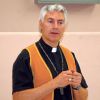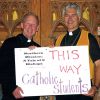Pope names Chatlain new archbishop of Keewatin-Le Pas
OTTAWA - Pope Benedict XVI named Bishop Murray Chatlain of Mackenzie-Fort Smith, Northwest Territories, to be the new archbishop of Keewatin-Le Pas, Man.
Edmonton twins with northern diocese
EDMONTON - The Edmonton archdiocese and the diocese of Mackenzie-Fort Smith have entered into a twinning arrangement that may lead to more co-operation between the two dioceses.
Edmonton has sent a priest to Mackenzie-Fort Smith and will give half the proceeds from its Nov. 21 Jubilee Gala to this northern diocese to help pay for a new church.
“This is sort of a partnership of mutual support and mutual enrichment,” said Archbishop Richard Smith, who will visit Mackenzie-Fort Smith in March.
In an Oct. 15 interview, the archbishop said this type of twinning arrangement goes back to the 1990s when Blessed John Paul II in his apostolic letter Ecclesia in America encouraged the dioceses of the Western Hemisphere to consider ways that they may enter partnerships with one another of mutual support.
As the question arose about a partnership between Edmonton and another diocese, Smith said his thoughts naturally turned towards South America.
“But as we talked internally about this more and more the question came up what about the needs of our people in the North of Canada?” he said.
The idea of Edmonton, the gateway to the North, twinning with Mackenzie-Fort Smith resonated with local Catholics, he said. Smith said the twinning also recognizes that the Edmonton archdiocese was established through the efforts of missionaries.
“We are the result of a missionary effort and that’s a reminder to us that the Church is and must always be missionary in its outreach.”
Mackenzie-Fort Smith Bishop Murray Chatlain said he is pleased with the twinning. Apart from the sharing of human and material resources, it “will give people (in the Edmonton archdiocese) a chance to understand more who we are, what our life is like and what are some of our blessings and challenges.”
The wheels of the twinning agreement are already in motion. Last June, youth leader Andrew Papenbrock visited Mackenzie-Fort Smith to lead a workshop on youth ministry. Since then, Papenbrock has helped the northern diocese with other youth ministry issues, Chatlain said.
As well, Fr. Arlan Parenteau, an Edmonton priest, was recently sent to serve the northern diocese. “Obviously this is a sacrifice on our part because we certainly need every priest that we can have, but at the same time we have to recognize that the Lord calls us to be generous,” Smith said. Smith said the two dioceses will ask what gifts they can share. When Chatlain spoke in Edmonton at the archdiocese’s Nothing More Beautiful event, Smith recalled, he talked about the great importance that is placed in the North on silence in the encounter with the other.
“That’s something our busy Western culture needs to learn — the value of silence and, within silence, encountering the reality of the other and encountering the reality of God in our midst.”
Chatlain said many people in his diocese travel to Edmonton, especially when facing serious medical issues, and end up attending the city’s parishes. The partnership may enable a deepening of those relationships, he said.
Chatlain said Mackenzie-Fort Smith and Edmonton are also encouraging the twinning of parishes from the dioceses. Funds from the Jubilee Gala, which he will attend, might be used to help renovate the church in Tuktoyaktuk and build a new church in Fort Simpson.
The Mackenzie diocese has 11 priests to cover about 38 communities.
“If we have 10 or 11 healthy priests, I think for the size we are it’s okay,” he said.
“What we are trying to do is to encourage the local leadership.”
Lay people, Chatlain said, lead services, funerals, Baptisms and even perform marriages.
(Western Catholic Reporter)
Two bishops tell students tales of Catholic life up North
TORONTO - The urban youth from Canada’s largest city got a crash course in northern life with the visit of two bishops who experience Canada’s far north every day.
Bishop Murray Chatlain of the Mackenzie-Fort diocese and Whitehorse Bishop Gary Gordon were in Toronto in late September and early October to raise awareness of the financial and physical hardships of their missions in the northern territories. The bishops were on a tour organized by Catholic Missions In Canada.
During an Oct. 1 presentation in collaboration with Ryerson University’s chaplaincy, Chatlain shared pictures of a rotting church in Fort Simpson, N.W.T. He told the small crowd in St. Michael’s Parish Hall that the Catholic community in Fort Simpson has raised $80,000 over the last three years to repair the church. But the total costs will run about $500,000.
“The Catholic community in Fort Simpson has not lost hope because they know they’re going to get some financial help from Catholic Missions In Canada,” said Chatlain. “They hope for a new church in a year or two.”
Another major cost for both bishops is travel expenses. Chatlain’s diocese covers 1.5 million square kilometres, the largest geographical diocese in the world. He flies 75 per cent of the time to reach different communities and a return trip costs $2,300 every time.
To reach all the communi
ties of his diocese in the Yukon, Gordon drives his truck about 35,000 km every year. He is able to fill the truck with gas with the funding from the Catholic Missions.
“The bottom line is we wouldn’t be where we are if it weren’t for the Catholic Missions In Canada,” said Gordon.
Catholic Missions was founded in 1908 and was first known as the Catholic Church Extension Society of Canada. Its main mission today is to help catechists and expand faith growth in hard to reach communities across Canada. Many First Nations communities in the Canadian territories are among the missions in need.
Gordon explains that some towns in his diocese are so far away from a more urban setting, such as Whitehorse, that there will be no priest to serve the Catholic community for months.
“The First Nations people do not want a hand out but they want a hand up,” said Gordon. “We are at a time of transition of finding people with the vision of the Church who have sense and ability to be the hand up.”
Chatlain added that the missions need as much as help as they can get from Catholic teachers, medical personnel and laypeople. His diocese serves 38 communities with huge distances between each.
Educating other people about First Nations was emphasized by both bishops. They visited high schools in the Toronto area to talk about the climate challenges and emotional problems such as alcohol abuse, violence and high suicide rates within First Nations’ communities.
“The First Nations people are people of the land. They don’t want huge communities and their people have lived on that land for thousands of years. It is the land where their ancestors are buried and family is so important to them,” said Chatlain.
Chatlain also mentioned that student groups from London, Ont’s King’s College volunteer for one month in one northern diocese. And for the past two years, the National Evangelization Team (NET) from Ottawa has been bringing young adults to volunteer for eight months. The volunteers get to know the people, join youth gatherings and visit the smaller communities spread across the diocese.
Potential volunteers can also contact the diocese by phone or e-mail, and it is advisable to have a reference from a priest ready. The diocese works out a time frame that someone is available to volunteer and plans around that schedule.
“God calls a certain type of person to work up North. It takes openness to the different ways the First Nations work. It is a trust thing,” said Chatlain.
(Jereza, 18, is a second-year journalism student at Ryerson University in Toronto.)



